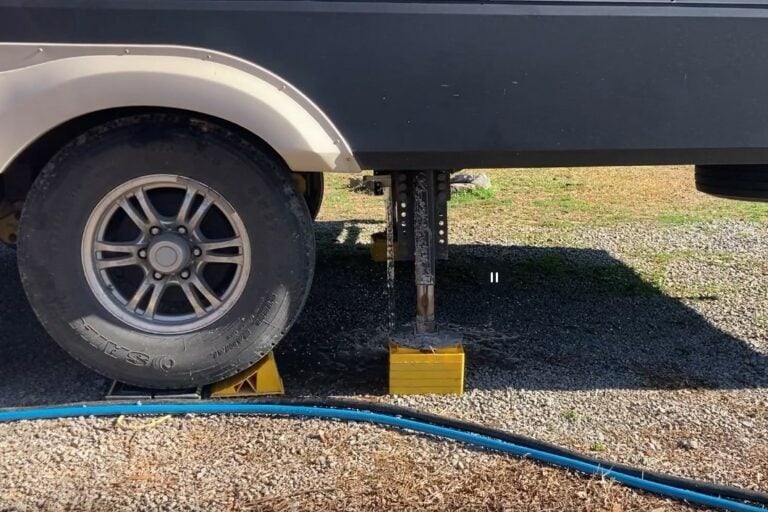This post may contain affiliate links. See our affiliate disclaimer here.
Need to drain your RV fresh water tank to reduce weight or prepare your RV for storage? We’ve got you covered. Our easy to follow guide will walk you through how to empty an RV fresh water tank.
Contents
How to Empty RV Fresh Water Tanks
In this step-by-step guide, we will share how to fully and properly empty an RV fresh water tank. We also share how to drain all water left in the lines and the hot water tank.
Step One: Turn Off the Water Heater
Turn off the water heater. Allow at least a couple of hours before proceeding to allow time for the water in the tank to cool.
Step Two: Open RV Faucets

Turn off your RV’s water pump. Then, open all of the faucets in your RV, including the sinks, shower and outdoor shower. Flush the toilet. Opening the faucets removes any pressure in the RV’s plumbing lines.
Step Three: Empty the Fresh Water Tank
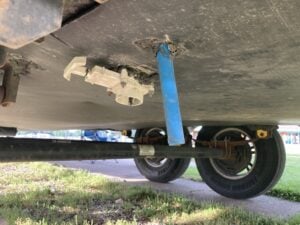
Most RVs have a fresh water drain valve underneath the RV, like the white valve pictured above. It is typically located towards the rear of the RV. Locate the valve, and open it to release the water in the tank. Open the drain valve slowly to prevent splashing water.
Step Four: Locate the Low Point Drains
Next, locate the low point drains under your RV. The low point drains are red and blue hoses (hot and cold water) with valves or small plastic caps keeping them closed. Unscrew the caps or open the valve to let any additional fresh water drain out of the RV.
Step Five: Drain the Lines
Turn the RV’s water pump back on, and open all the faucets in the RV. This will allow any additional water left in the lines to drain into the gray water holding tank.
Step Six: Empty the Hot Water Heater (Optional)
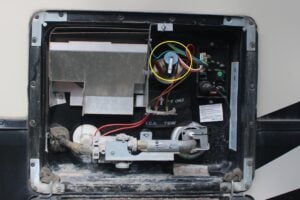
If you need to empty your RV’s entire fresh water system for winterizing or storage, you should also drain the hot water tank.
Locate and open the water heater access on the outside of your RV. Flip up the lever on your pressure relief valve to remove any pressure from the water heater. I have circled the pressure relief valve in the above image.
Loosen the water heater plug or anode rod using a socket or wrench, until it is hand tight. Use one hand to lift the pressure relief valve, and finish removing the plug with your other hand. Allow the water heater to fully drain.
Once the water heater has fully drained, reinstall the plug. Wrap the plug in plumber’s tape, then place the plug back in and use your hand or a wrench to tighten it in place. Finally, flip the pressure relief lever back down and close the water heater access.
Step Seven: Drain the Gray Water Tank (Optional)
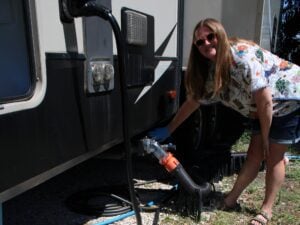
If you are draining the entire system, also go ahead and dump your gray water tank. Since gray water contains soaps and other chemicals, the tank must be emptied into a dump station. It cannot be dumped on the ground. See our complete guide to RV holding tanks for step-by-step instructions.
When to Empty RV Fresh Water Tanks
Now that you know how to empty an RV fresh water tank, let’s talk about when you need to empty the tank.
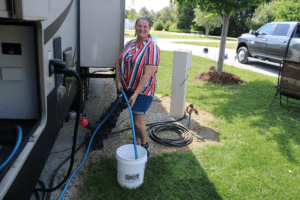
Before Storage and Winterizing
Anytime your RV is going to be unused for two weeks or more, you should empty the fresh water tanks. The tanks also need to be completely emptied when winterizing your RV. See our complete guide to winterizing your RV for more important storage tips.
Before Driving
While your RV’s fresh water tank does not need to be completely empty for driving, it is important to consider the weight of water in your RV. Ideally, RVers should drain the majority of fresh water from their tank before hitting the road.
Leave just enough water in the tank to use for bathroom stops. If you need to fill up your tanks before heading to a boondocking spot, look for the closest water fill to the campsite.
Before Sanitizing the Tank
To ensure your RV drinking water is safe, the fresh water tank needs to be sanitized before and after long periods of storage and after contamination. The first step in sanitizing the fresh water tank is draining it. Click here for our step by step guide to cleaning an RV fresh water tank.
FAQs about Emptying an RV Fresh Water Tank
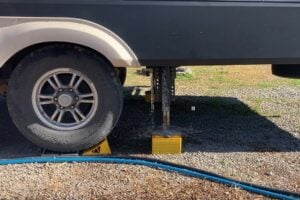
When should I empty my RV fresh water tank?
Fresh water tanks on RVs should be emptied before sanitizing the tank, before winterizing the RV and anytime the RV is not being used for two weeks or more.
How do I empty an RV fresh water tank?
Locate the fresh water drain valve on the underside of your RV. After turning off the waters heater and water pump, open faucets to release pressure. Then, slowly open the drain valve to empty the fresh water tank.
What is the low point drain on an RV?
Low point drains are valves located near the lowest point on an RV. Most RVs have a hot water (red) drain and a cold water (blue) drain. Opening the low point drains allows fresh water to fully drain out of the RV.
What is the fresh water tank in an RV?
The fresh water tank in an RV stores potable water. Using the RV’s water pump, water can be pumped from the fresh water tank to the RV’s sinks, showers and toilets.
Where can you empty an RV fresh water tank?
As long as the water in the tank has not been contaminated, it is safe to dump fresh water on the ground. RV owners should be considerate and avoid flooding campsites and areas where other campers will walk.
Thanks for reading our guide on how to empty an RV fresh water tank. For more RV care tips and tricks, see our RV maintenance checklist.
If you have any additional questions about RV holding tanks, drop them in comments section below.
Happy Camping!

Christina Pate is a seasoned full-time RVer who, along with her husband Justin, has journeyed across the US, Canada, and Mexico. Drawing from her extensive travels, RV repairs and RV renovations, she founded Travels with Ted to guide and inspire fellow RV enthusiasts. Christina is also the co-author of The Owner’s Guide to RV Maintenance and the creator of My RV Log Book.

